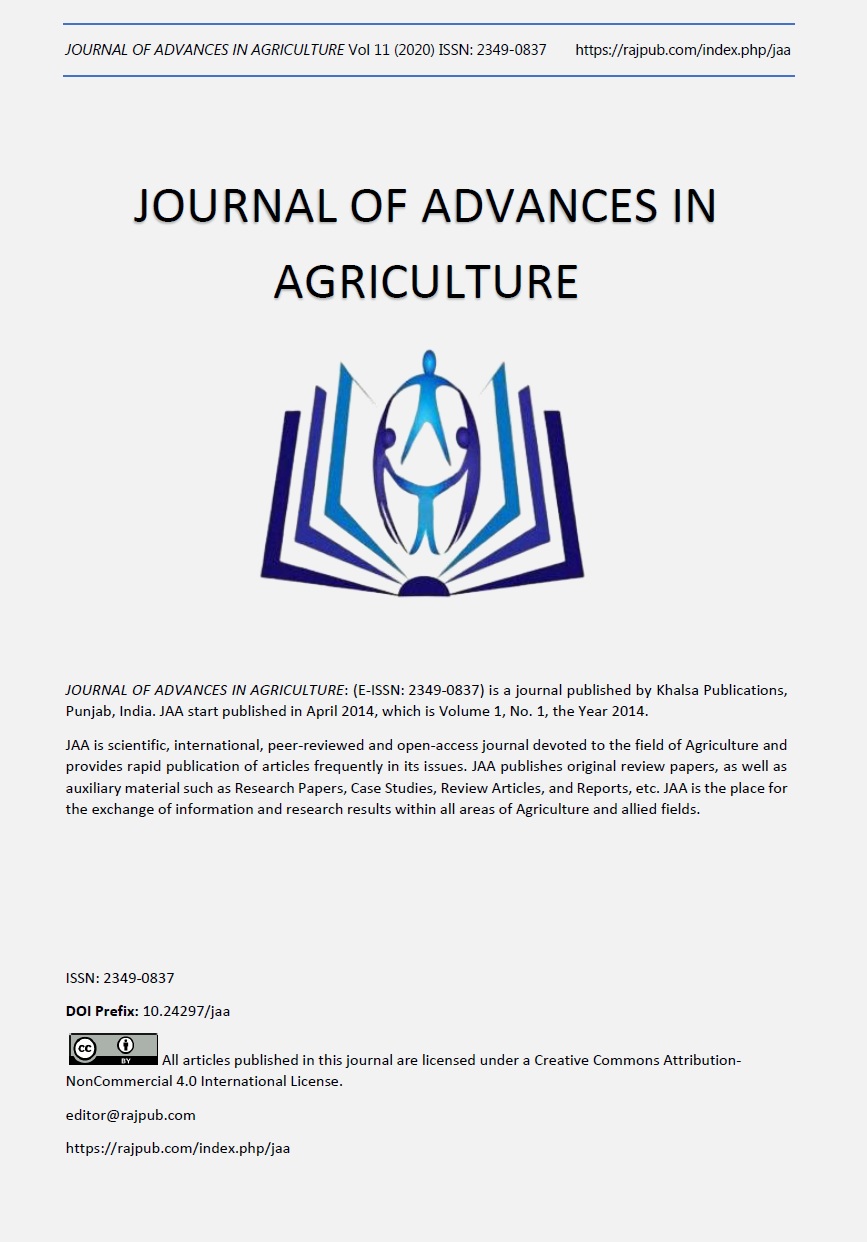Southern Sandbur (Cenchrus echinatus L.) Control in Bermudagrass Pastures with Indaziflam Herbicide Systems
DOI:
https://doi.org/10.24297/jaa.v11i.8738Keywords:
Cenchrus Echinatus , ‘Coastal’ Bermudagrass, Cynodon Dactylon (L.), N-[(1R.2S)-2,3-Dihydro-2,6-Dimethyl-1H-Inden-1-Yl]-6-(1-Fluoroethyl)-1,3,5-Triazine-2,4-DiamineAbstract
Field studies were conducted during 2019 growing season in north-central, south-central, and the Coastal Bend areas of Texas to evaluate indaziflam herbicide systems for southern sandbur control and Coastal bermudagrass tolerance. Indaziflam caused no bermudagrass stunting at any location when applied preemergence (PRE) at 0.04 to 0.07 kg ai ha-1. Glyphosate at 0.35 kg ae ha-1 caused bermudagrass stunting which ranged from 16 to 65% when evaluated 3 to 5 weeks after application; however, when evaluated at the end of the growing season, no bermudagrass stunting was evident when compared with the untreated check. Southern sandbur control with indaziflam, when evaluated 28 to 32 weeks after the initial indaziflam PRE application, ranged from 85 to 99% in north-central Texas, 65 to 95% in south-central Texas, and 95 to 100% in the Coastal Bend region. Southern sandbur control with pendimethalin PRE system ranged from 74 to 100%, 11 to 85%, and 100% in those regions, respectively. Indaziflam represents a safe option for forage and hay producers in Texas to control southern sandbur.
Downloads
References
Alsonso, D. G., Koskinen, W. C., Oliveira Jr., R. S., Constantin, J., and Mislankar, S. (2011). Sorption-desorption of indaziflam in selected agricultural soils. J. Agric. and Food Chem. 59:13096-13101. doi: 10.1021/jf203014gPMID:22070170
Anonymous. (2017). Registration of Specticle FLO. https://www3.epa.gov/pesticides/chem_search/ppls/000432-01518-20110907.pdf
Brosnan, J. T., and Breeden, G. K. (2012). Application placement affects postemergence smooth crabgrass (Digitaria ischaemum) and annual bluegrass (Poa annua) control with indaziflam. Weed Technol. 26:661-665.
Brosnan, J. T., Breeden, G. K., McCullough, P. E., and Henry, G. M. (2012). PRE and POST control of annual bluegrass with indaziflam. Weed Technol. 26:48-53.
Claus, J. S. and Behrens, R. (1976). Glyphosate translocation and quackgrass rhizome bud kill. Weed Sci. 24:149-152.
Frans, R., Talbert, R., Marx, D., and Crowley, H. (1986). Experimental design and techniques for measuring and analyzing plant responses to weed control practices. In: Camper, N. D., (ed.)
Research Methods in Weed Science. 3rd ed. Champaign, IL: Southern Weed Science Society. Pp.29-46.
Gottrup, D., O’Sullivan, P. A., Schraa, R. J., and Vanden Born, W. H. (1976). Uptake, translocation, metabolism, and selectivity of glyphosate in Canada thistle and leafy spurge. Weed Res. 16:197-201.
Grichar, W. J., Jaks, A. J., and Nerada, J. D. (2000). Field sandbur (Cenchrus pauciflorus) control in pastures using Gramoxone, Roundup Ultra, or Touchdown. Texas J. of Agri. and Natl. Resources. 13:1-7.
Grichar, W. J., Baumann, P. A., Baughman, T. A., and Nerada, J. D. (2008). Weed control and bermudagrass tolerance to imazapic plus 2,4-D. Weed Technol. 22:97-100.
Grey, T. L., Luo, X., Rucker, K., and Webster, T. M. (2016). High density plantings of olive trees are tolerant to repeated applications of indaziflam. Weed Sci. 64:766-771.
Gould, F. W. (1975). The Grasses of Texas. Texas A&M University Press, College Station, TX. pp. 565-567.
Holm, L. G., Plunknett, D. L., Pancho, J. W., and Herberger, J. P. (1991). The World’s Worst Weeds. Distribution and Biology. Krieger Publ., Malabar, FL.
Hurdle, N. L., Grey, T. L., McCullough, P. E., Shilling, D., and Belcher, J. (2019). Bermudagrass tolerance of indaziflam PRE applications in forage production. Weed Technol. doi. 10.1017/wet.2019.76.
Jhala, A. J. and Singh, M. (2012). Leaching of indaziflam compared with residual herbicides commonly used in Florida citrus. Weed Technol. 26:602-607.
Jones, P. A., Brosnan, J. T., Kopsell, D. A., and Breeden, G. K. (2013a). Effect of reed-sedge peat moss on hybrid bermudagrass injury with indaziflam and prodiamine in sand-based root zones. Weed Technol. 27:547-551.
Jones, P. A., Brosnan, J. T., Kopsell, D. A., and Breeden, G. K. (2013b). Soil type and rooting depth affect hybrid bermudagrass injury with preemergence herbicides. Crop Sci. 53:660-665.
Marble, S. C., Chandler, A., and Archer, M. (2016). Impact of application rate, timing, and indaziflam formulation on early POST control of Oxalis stricta. Weed Technol. 30:701-707.
Matocha, M. A., Grichar, W. J., and Grimes C. (2010). Field sandbur (Cenchrus spinifex) control and bermudagrass response to nicosulfuron tank mix combinations. Weed Technol. 24:510-514.
Sandberg, C. L., Meggitt, W. F., Penner, D. (1980). Absorption, translocation, and metabolism of 14C-glyphosate in several weed species. Weed Res. 20:195-200.
Sebastian, D. J., Nissen, S. J., Westra, P., Shaner, D. L., and Butters, G. (2017a). Influence of soil properties and soil moisture on the efficacy of indaziflam and flumioxazin on Kochia scoparia L. Pest Manag. Sci. 73:444-451.
Sebastian, D. J., Fleming, M. B., Patterson, E. L., Sebastian, J. R., and Nissen, S. J. (2017b). Indaziflam: a new cellulose-biosynthesis-inhibiting herbicides provides long-term control of invasive winter annual grasses. Pest Manag. Sci. 73:2149-2162.Shaner, D. L., ed. (2014). Herbicide Handbook. 10th edition. Weed Science Society of America. Champaign, IL. 500 pgs.
Torres, B. A., Meneghin, S. P., Ribeiro, N. M., dos Santos, P. H. V., Schedenffeldt, B. F., and Monquero, P. A. (2018). Saflufenacil and indazifam herbicide effects on agricultural crops and microorganisms. African J. Agric. Res. 13:872-885.
US EPA. Pesticide fact sheet. Conditional registration. July 26, 2010; pp. 1-108.
Waldecker, M. A. and Wyse, D. L. (1985). Soil moisture effects on glyphosate absorption and translocation in common milkweed (Asclepias syriaca). Weed Sci. 33:299-305.
Walker, R. H., Wehtje, G., and Richburg III, J. S. (1998). Interference and control of large crabgrass (Digitaria sanguinalis) and southern sandbur (Cenchrus echinatus) in forage bermudaagrass (Cynodon dactylon). Weed Technol. 12:707-710.
Downloads
Published
How to Cite
Issue
Section
License
Copyright (c) 2020 Scott Nolte, James, Josh, Zach, James Grichar

This work is licensed under a Creative Commons Attribution 4.0 International License.
 All articles published in Journal of Advances in Linguistics are licensed under a Creative Commons Attribution 4.0 International License.
All articles published in Journal of Advances in Linguistics are licensed under a Creative Commons Attribution 4.0 International License.




